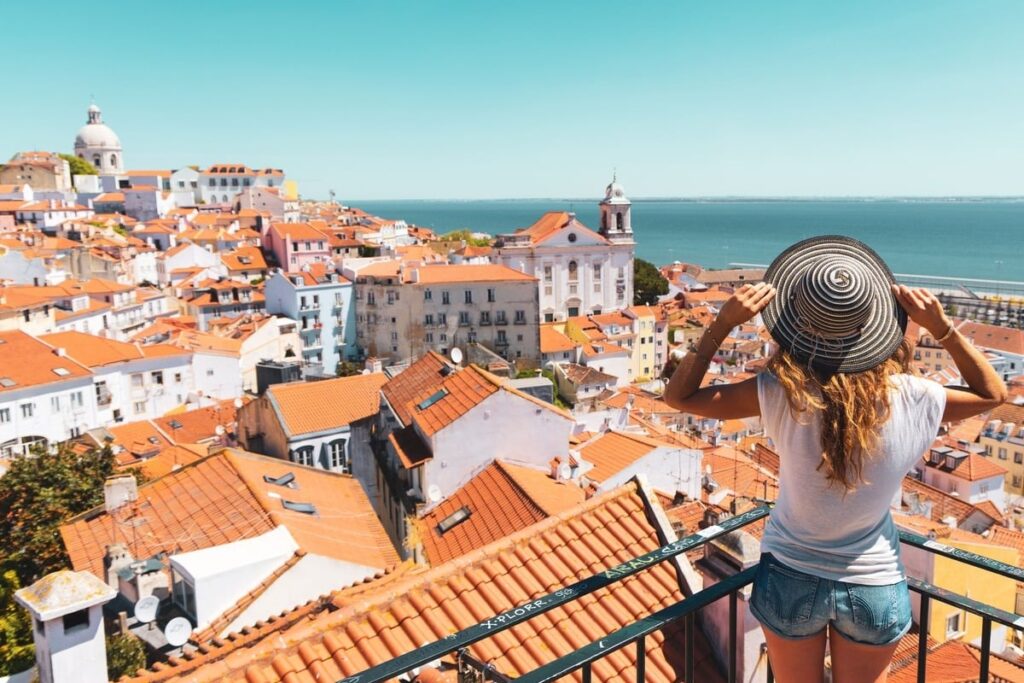Travel Guide
Portugal’s Tourist Boom: Is It Still A Must-Visit Or Completely Overrun This Summer?
Last Updated
Long gone are the days when Portugal was a forgotten, peripheral Western European country Americans would fly over on their way to Spain without giving it much of a thought.
Having been to Portugal both before it became popular, and after its post-2022 tourist boom, I can say that’s definitely not the case anymore: it is jam-packed with U.S. visitors, and you’d be lucky to not get photobombed even in the quietest of Lisbon backstreets.
As overtourism begins gaining momentum in Portugal, and prices start to increase, as they once did across its fellow Southern European brothers Spain and Italy, now a bit too crowded and expensive, it’s time we pose the most difficult of questions:
Is the Iberian gem still worth visiting, or is it overrun with tourists already?

First Of All, Why Are Tourists Flocking To Portugal All Of A Sudden?
Portugal is a tiny country in Iberia, a peninsula it shares with Spain. While its bigger, more famous neighbor lays claim to the Mediterranean coast, however, Portugal faces the wild North Atlantic, being the westernmost point of mainland Europe.
Other than having presided over one of the richest Transatlantic empires known to mankind, having spawned global superpower Brazil, Portugal is widely known for its ancient culture: from Celtic tribes to the Romans to the Moorish to the Portuguese crown, its History spans at least 3,000 years.

Lisbon, the Portuguese capital, is built across seven hills, as dictated by Roman policy, and with its maze of winding cobbled streets, that yellow heritage trams rattle through, monumental medieval churches and monasteries, and imposing castle, it’s the quintessential postcard city.
Up north, Porto is known for its stately Baroque palaces, tile-decorated shrines and double-deck bridge spanning a scenic river, not to mention the stunning Portuguese landscapes: family-owned vineyards, verdant nature, and sun-kissed coast extending as far as the eyes can see.

This all sounds great, but if you’ve been following the news at all lately, you’re aware anti-tourist sentiment is growing in Portugal, as locals join their Spanish and Italian friends in protesting the presence of visitors, and the ongoing gentrification of Portuguese cities.
Portugal Gets A Bitter Taste Of Overtourism
I’ll be honest with you, 2024 Portugal is a far cry from the Portugal I knew from my early years: I have visited this country more times than I can count, and two things that stood out to me in the last couple of times over is the sheer volume of tourism, and the surging prices.

I was no longer able to find peace and quiet strolling Alfama, the most picturesque district of Lisbon, in the wee hours, what with the Instagrammers queuing up for sunrise pictures in the nearest miradouro, and the friendly smiles I would usually be offered at coffee shops now feel… not genuine.
Don’t get me wrong, Lisbon makes for a great city break, and the cultural value truly is remarkable, but the overall tourism fatigue shows; the same is true of Porto, the ever-busier Algarve, which has just started hosting its first U.S. flights, and fairytale-like, yet no-longer laid-back Sintra.
So, is Portugal still worth visiting, considering the ‘novelty’ factor has arguably worn out? The short answer is yes, and I will tell you why:
This Is Why Portugal Is Still Worth Visiting Amid Tourism Boom

Yes, main cities have become perhaps as busy as Barcelona, Paris and Rome, and you’d be lucky to find hotel overnights for under $127 in the peak of summer—so much for the supposed cheapest country in Western Europe—but fortunately for us, off-path explorers, the bulk of Portugal remains undiscovered.
It won’t stay this way for long, but you can still find that unspoiled golden coastline and historic town that looks not only frozen in time but virtually oblivious to the tourism woes plaguing the capital and its Northern counterpart, Porto.

Evora is one such example of a hidden gem country-hoppers touring Portugal for 3-5 days are skipping altogether: 1h30 from Lisbon by train; it is a Roman-era settlement home to a landmark Diana Temple, a UNESCO-listed monument standing for over 2,000 years.
If you love Game of Thrones, you’re sure to be mesmerized by Batalha: dating back to the Middle Ages, its mighty Gothic monastery was a filming location for Game of Thrones, and if you’re not bringing a map with you, you could easily get lost in its Hogwarts-like, eerie corridors.

Portugal is also full of the so-called destination dupes: towns that share certain key characteristics with popular tourism hotspots yet are far less crowded.
Two noteworthy examples are Aveiro, a city of canals lined by colorful houses that rivals Venice, and Carvoeiro, the Portuguese Santorini: picture a collective of blanche villas perched atop small cliffs, overlooking a bright-blue ocean.
The Algarve coastal stretch running from Faro to Lagos may be overrun with resort-loving big spenders, but quaint Ericeira, an even shorter 43-minute drive from the capital, offers sun-seekers the same golden sands, whitewashed fishermen houses, and charming praças for a fraction of the price.

If you love nature, then you’ll love the next part:
The Portuguese Islands Remain Largely Unexplored
Portugal may be teeming with foreign guests, but as of right now, most of them will be traveling exclusively in the European mainland while ignoring the Portuguese archipelagos altogether:
Yes, Portugal has a bunch of holiday islands to its name with the kind of breathtaking nature that needs seen to be believed.
Out of those, Madeira is the up-and-coming spot, a volcanic island surrounded by the azure Atlantic, where epic hikes with views of deep valleys and jagged peaks, ethnic villages nestled amid banana plantations and black-sand beaches await discovery.

Madeira’s small sister, the tiny Porto Santo, is characterized by its arid, plain terrain, thin white sands hugged by teal-colored waters, a rare occurrence in this part of the North Atlantic, and affordable beachfront stays.
Speaking of affordability, the Madeira-Porto Santo duo are some of the cheapest summer destinations in Europe.
Guesthouse rooms starting from as cheap as $54, such as AL Moniz in Machico, and for the odd sybarite—hem, rarely-employed word that effectively means ‘a luxury addict’—the four-star Estalagem in Ponta do Sol, the sunniest corner of Madeira, has nightly rates starting from only $161.

I was a guest at a week-long digital nomad event in Estalagem in late 2023 myself, and blimey, the sun setting over the sea and tinging the sleepy historic town golden at dusk took my breath away every single time.
Wait, don’t leave just yet.
I know it’s getting lengthy, and my wordiness tends to irk some, but I didn’t even get to introduce you to the beautiful Azores, the Hawaii of Europe.
We’d need an entire, separate article for that, but I’ll keep it brief: if you haven’t been to an Azores island yet, you’re missing out on the trip of a lifetime. I’m talking about impressive calderas, UNESCO-protected biosphere reserves, majestic waterfalls, and thermal springs.

There are nine islands in total, and whether you’re the adventurous kind, you’re here for the culture, or you’re looking for a stress-free escapade to a subtropical paradise where the weather is just mildly warm year-round (none of the scorching Southern European heat), trust me you’ll be served.
Like Madeira, the Azores are incredibly affordable to visit, too:
If you’re on a shoestring budget, the Pes Verdes Hostel in Sao Miguel, the busiest island, has listed dormitory beds for a negligible $24; now, if you can’t trade in privacy for the cheapest rate, staying in privately managed Casa Branca will only set you back $49 per night.

Phew. That was the long answer.
Onto the conclusion now, and for your own sake, stay on this page. There’s more I haven’t told you yet.
How To Avoid Overspending In Portugal
Portugal is still worth visiting, especially when there’s so much land that remains untrodden, and let’s be honest: you’ll only break the bank if you’re not clever about how you spend your tourist dollars.
Hotel prices are slowly approaching those of the rest of Southern Europe, but on the bright side, food remains relatively cheap, even in Lisbon, Porto, Lagos and the like: in any Portuguese-frequented pastelaria, expect to pay $5 or less for a lunchtime savory pastry and a soft drink.

Menus in regular restaurants can have prices that are just as attractive, and it’s still possible to spend under $15 on a generous bacalhau portion and a cheeky glass of wine if you move just slightly away from that crowded, souvenir shop-lined pedestrianized street.
Personal tip? When looking for a cheap place to eat, and eat well, keep an ear out for some of that lively Portuguese chatter when you pass by a restaurant: no native tuga in their right mind will share a dining hall with the far richer, prone-to-paying-more American.

They may not be the most Instagrammable or adorned with decorative tiles and flowery arrangements, nor do they have a hidden garden inhabited by Lisbon’s infamous proud peacocks, but the food is generally great, and the pricing is fair.
Remember: the median wage in Portugal remains far lower than that of the average American worker, averaging $886 in 2024, so you’ll only spend over $50 on a meal if you want to spend $50 on a meal.
My final tip for enjoying Portugal in this current climate, with overtourism knocking on its front door?
Well, just don’t be another average tourist.
↓ Elevate Your Travel↓
Sign Up Now For Travel Off Path Premium! No ads, VIP Content, Personal Travel Concierge, Huge Savings, Daily Deals, Members Forum & More!

✈️Join Our Travel Off Path Community Forum: Where travelers unite, ask questions, share experiences and even find like-minded travel buddies!
SUBSCRIBE TO OUR LATEST POSTS
Enter your email address to subscribe to Travel Off Path’s latest breaking travel news, straight to your inbox.
This article originally appeared on TravelOffPath.com
Opinions expressed here are the author’s alone, not those of any bank, credit card issuer, hotel, airline, or other entity. This content has not been reviewed, approved or otherwise endorsed by any of the entities included within the post.

